|
 |
|
 |
|
 |
 |
| |
16:9 in English: The Real Thing is Something Else
Af HENRIK SMED NIELSEN
“The real thing is something else” is a quote from the trailer to Robert Montgomery’s 1947 film Lady in the Lake. Inadvertently, it describes what the experience of this particular film is all about. Addressing the audience from behind his desk, the film’s main character, detective Philip Marlowe sets the scene for the case of the Lady in the Lake: “What you have read and what you have heard is one thing – the real thing is something else”. And it is exactly this “real thing” Lady in the Lake wants you to experience. The film involves the audience in a murder mystery to an unprecedented degree. Marlowe encourages us to participate: “You’ll see just as I saw it, you’ll meet the people, you’ll find the clues, and maybe you’ll solve it quick… and maybe you won’t”.
Although Lady in the Lake is a classic detective story it has the peculiarity of being told through a first person perspective. The first person perspective is to be taken very literally. To again quote the trailer “The camera acts! – A revolutionary innovation in film technique”. That is, the camera is placed at the position of Philip Marlowe following his every move. As spectators we now see with the eyes of Marlowe and experience what he experiences from a first person perspective. What would be more engaging and thrilling than to be Philip Marlowe for a day?
|
|
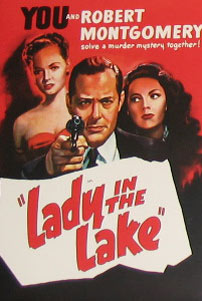
|
|
| |
As promised by the trailer the audience faces a “innovative, daring” and “startling” new way of storytelling. However, I doubt that anyone who has seen the film would argue the claim that it lives up to this setup. The real thing is in fact something else. The merging of the camera and Philip Marlowe does not immerse the spectator in the murder mystery. Rather the film facilitates the quite opposite experience, e.g. characterized by Joseph V. Mascelli as “dull” (1965, p. 18) and by Noël Burch as “bizarre” (1990, p. 254). The supposed thrill of being a private detective is replaced with a sense of discomfort or disbelief regarding what happens on the screen (fig. 2.). The first person experience of the Lady in the Lake is in some way in-authentic. It just does not feel right. Why?
The Subjective Shot
The main problem is the film’s way of facilitating the first person experience. Particularly its use of what is formally known as the subjective shot. The subjective shot is a variant of the optical point of view shot (1). Here the camera assumes and merges with a character both visually and subjectively. Not only showing what a subject sees (as in an optical p.o.v.), but also how the subject sees. Such subjectivity – a character’s mental or perceptive state of mind - may be facilitated via camera position, camera movement, and different editing techniques. Furthermore, subjective shots might invoke a sense of physicality or embodiment, explicated as the blurry vision of an intoxicated, drunk, or in another way affected body of a character. |
|

Fig. 2. The film’s femme fatale Adrienne Fromsett (Audrey Totter) unknowingly mirroring a common spectator expression.
(1) An extensive account for the point of view shot can e.g. be found in Edward Branigan’s Point of view in the cinema, 1984. |
|
| |
Regarding Lady in the Lake the purpose of the subjective shots is pointed out in the opening scene. As Philip Marlowe faces the camera he retrospectively sets the stage for what we are about to see. He stresses that you as a spectator will see what he saw, experience what he experienced. In other words, the shots are used to merge the spectator, the camera, and Marlowe. The spectator is to experience on a first hand basis, what it is like to be wound up in a murder mystery. Consequently, this first person perspective is cued by; continuous tracking shots and the sound of footsteps, a right and a left arm entering the frame grabbing things or opening doors, smoke emerging up in front of the camera from a lit cigarette (fig. 3.), phone receivers entering its vision, and Adrienne Fromsett (the films femme fatale) almost bumping her head against it when kissing Marlowe (fig. 4.). In addition, other characters address this moving and acting entity as detective Philip Marlowe, by looking and talking to the camera with matters concerning the murder mystery. Consequently, a male voice replies and presents itself as Philip Marlowe.
The subjectivity of the shots is most evident when the camera mimics human perception. When Marlowe confronts Chris Lavery (a suspect in the case) he is knocked unconscious. As Lavery hits him, the camera movement indicates a body being hit, as it falls to the ground. A simultaneous fade to black shows that the body’s way of seeing is affected from the punch. Likewise, certain mise-en-scene elements - the door, door frame, and Marlowe’s hand - are blurred as he listens in on a conversation through a gaping door. That is, when objects differ from the intentional interests of Marlowe – door and door frame vs. the conversation in the other room – the objects of less subjective interest are shown out of focus (fig. 5.). We see how Marlowe perceives with certain interest in certain objects and characters.
The experience of this first person perspective, which seems to be cued rather logically, appears puzzling. Mascelli (among others) emphasizes the lack of Marlowe’s facial expressions and a subsequent impossibility for identification as the main reasons for this ambiguity. The experiment also lends itself to other points of criticism such as the intermittently imprecise focalization of the camera or an incongruence of the camera as a mechanical apparatus and characters as human agents. I wish, however, to propose a different take on the issue. It is correct that the vision of the camera does not fit Marlowe’s body and vice versa but this is not because of an alleged mismatch of mechanical apparatus (camera) and human agent (character), quite the contrary. Marlowe’s body and the camera stumble upon each other in a, supposedly, common and unified perception in objects and characters of the fictional world. The film’s bizarre effect is not grounded in how we experience characters in it, but rather how we experience film as such.
The Film Experience from a First Person Standpoint
In The Address of the Eye (1992) Vivian Sobchack sets out to examine how the film is able to signify. She grounds the film’s power to have sense and to make sense in our own existential and bodily presence in the world (pp. 3-6). Sobchack uses phenomenology as a way of descriptively revealing the essential structures of the film experience.
As the name indicates, phenomenology is concerned with the study of phenomena. Instead of attending to things of experience, phenomenology focuses on the experience of things. This sensitivity towards experience as intertwined with what is experienced entails an emphasis on consciousness and its structures of intentionality. That is, it is in consciousness that the world and its objects appear to us – it is as conscious beings that we have experiences of the world (Cerbone 2006, pp. 1-4). The main feature of experience is intentionality, meaning that experience is always directed and about something. As conscious beings we are always situated with a certain perspective on things. Phenomenology sees us as intertwined with the world in an inseparable way, stressing that we never experience things in isolation, but as relational. Instead of objectifying the world, phenomenology insists on a holistic view. To understand the world and study phenomena, we need to take the unity and totality inherent in our experience into account. Phenomenology’s notion of consciousness and experience entails some sort of subject “having” these – a point of departure for consciousness. This subject is essential in Sobchack’s quest to uncover how we experience film.
The Living Body
Our experience of the perceptual act of seeing is the fundamental precondition for both seeing the light hitting the screen and making sense of the visual representations. In other words; you have to “know” perception and the structures of seeing as an act, in order to understand how the film experience communicates and signifies. But how do we “know” perception as an act?
The French phenomenologist Maurice Merleau-Ponty emphasizes that meaning is given to us by constantly perceiving the world as a body. We do not understand and make sense of the world reflectively, reasoning and judging it from a distance. The relationship between consciousness and body is not like someone driving a car or operating a machine. Instead, consciousness is a lived body. We understand the world and make sense of it because we cannot escape our bodily relation with it – we are condemned to meaning (Cerbone 2006, pp. 105-108). The bodily subject has sense and makes sense as a lived-body whose perception is always already in connection with the world. It is as a lived-body that we have experiences of the world, hence it is also as a lived-body we perceive and experience the film. |
|
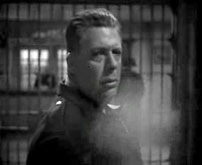
Fig. 3. Marlowe smokes as he is questioned by the police.

Fig. 4. Marlowe and Adrienne sharing a tender moment.

Fig. 5. Marlowe peeping through a door. |
|
| |
The lived-body holds the most fundamental structure of meaning in its continuous exchange of perception and expression. It can be illustrated via the reversibility present in our act of seeing; we do not only see objects, we also see ourselves (and others) as seeing the objects (and each other). We are always both subject and object of perception (3). It is because of my bodily expression in the world that my perceptions make sense and vice versa. I perceive and express perception as I move around in the world intending towards and acting with objects. Sobchack finds this exchange equally evident in the film experience. The film experience is something we understand by way of its perception and expression.
The Film as Perception and Expression
Sobchack speaks about film as transposing our mode of being-in-the-world in a way that counts for us as “direct” experience (1992, p. 4). Her notion of “direct” experience is connected with the structures of perception – the exchange of perception and expression – as grounding the experience of film. The structures of existential being as a lived-body are mimicked by the mechanics of the cinema – the camera perceives a given scene and the projector expresses its meaning. That is, film counts as “direct” experience because it is recognized as a visual conduct. The spectator sees the film as a visual conduct as it exists in relation to a world, objects, and others (p. 138). In a way similar to our act of seeing, the film has characteristics of intentionality, existentiality and embodiment. The camera intends towards, and shows interest in certain things and characters, thus implying an intentional correlation between a “seeing act” and a “seen object” (pp. 130-131). The existential features of the film’s acts of seeing reveal themselves in the selection of a certain visual field as opposed to another. That is, vision holds qualities of choice and expression by separating the visible from the invisible. And by stressing that seeing is only one modality of perception, intrinsically connected with others (touching, hearing, smelling) in the unity of the lived-body, Sobchack implies film as also having some sort of “body”. Vision as we know it, is an embodied phenomenon (p. 133).
Returning to the notion of “direct” experience; when film is recognized by its correlation of perception and expression, implying an existential embodiment, it also means that the vision of the film is not something the subjective viewer assumes as her/his own (p. 140). The film’s visible conduct is experienced as different from my own. In other words; we do not mistake our own and the film’s being – the films perception is always present as the perception belonging to “someone” else. This is not to say that film cannot affect us emotionally or that we do not identify with the characters on screen. But the experience as such and the film’s subsequent meaning as film do not require or depend on this. Rather the film is recognized as an anonymous other, sharing a similar way of perception and being-in-the-world (pp. 141-142). Film is not only an object of our perception but also a “subject” having its own perceptions of the world.
The Body of the Lady in the Lake
Evidently there is a discrepancy between the intentions of Lady in the Lake and Sobchack’s account of how we experience film. If film appears as the vision of another intentional, existential and embodied “subject” you will never mistake its view for your own. Hence, to experience what Marlowe experienced from a first person perspective is rendered impossible as the film is a “being” in itself, not Marlowe’s or the spectator’s. By way of our lived-body, we recognize visual conduct and intentionality always as implying a body. In consequence, the merging of Marlowe and the camera is just not possible as the body of the film is compromised. One body cannot occupy matching spatiotemporal coordinates and have experiences identical to another body. The body of the film cannot take on Marlowe’s perspective, his experiences, and his actions in the world without compromising its own and Marlowe’s material body. The in-authenticity originates from a misconception of the film’s body, as Lady in the Lake tries to convince the spectator that the film’s body is in fact Marlowe’s. But how can you misconceive a body you cannot see – a body that is only implied by its perception? When watching a film we typically do not - I would argue – pay attention to the body of the film. And this is exactly the point.
Paradoxically, just because the film’s body usually is invisible to us does not mean that it is not there. The experience of our own lived-body is transparent in a similar way. We do not experience ourselves as bodies experiencing the world, we just experience the world. Put differently, I do not have to locate my fingers, hand and arm in order to reach for my coffee mug. This familiarity is what characterizes most of my perceptions and actions in the world. The lived-body transcends itself and is always something more than a material body. Although, there are situations where I am reminded of the materiality of my bodily existence; if I burn my fingers on my mug with hot coffee, if I break a leg, or my bodily intentionality (perception and expression) in other ways are compromised. Sobchack actually characterizes the lived-body as having an “inhuman” feature when it breaks down and “do[es] not work” – the body becomes objectified (p. 219). |
|
(3) The reversibility of this fundamental structure of meaning can also be found in Edmund Husserl’s notion of the double touch. In touching one’s left arm with the right hand, one experiences a double touch – to touch and be touched – which explicates the distinctiveness of our being, and the inherent structure of meaning in our perception (Cerbone 2006, p. 104). |
|
| |
The film shares these traits, by literally being mechanical technology, yet, displaying intentional, existential and embodied visual conduct. The film’s “lived-body” shows itself in the experience of the film, as the lived-body is a totality of both materiality and intentionality. Like the human lived-body the film’s “lived-body” is something which in its intentional correlation with the world becomes transparent. We do not experience the film as a camera recording a scene, and a projector displaying it, we just experience the film. Like the human lived-body, the film’s “lived-body” displays an excess as it is experienced – it becomes and is more than its material parts and preconditions. Yet, the “lived-body” of the film can be compromised thus revealing the inhuman secret and causing the film to loose part of its excess. To Sobchack such instances can occur when the film...
...assumes a material disguise that is made explicit within the film’s immediate perception of itself. That is, another kind of material body than the film’s body is presented in the film’s perception as the film’s visual body enabling all its perceptions. (p. 220)
This is what happens in Lady in the Lake. Here the film puts on a “Philip Marlowe suit” in an attempt to disguise its own body and present Marlowe’s human body as enabling its perceptions. As the film’s habitual perception is compromised, its material body breaks down and shows its inhuman character. In other words; the awkwardness we experience in the Lady in the Lake, is founded on the film’s body as being something it is not.
Decomposing the Lived-body
As Lady in the Lake fails in giving an authentic first person experience, you might wonder if such an experience ever is possible when using subjective shots. To Sobchack, facilitating an existential perspective necessitates a sensibility towards time. The short and sporadic merge of the camera and a character (common use of subjective shots) means that most films do not claim that the material body of a character is the same as the material body of the film (p. 226). In consequence, Sobchack characterizes such use of subjective shots as a narrative appropriation of the film’s body and not an existential one. Elaborating on the film’s body, Sobchack points out Lady in the Lake as the prime example of the problems you face in the existential appropriation of the film’s body (p. 230). While she may be right concerning Lady in the Lake there are, however, other films that handle the existential appropriation of the film’s body less problematically.
The films I have in mind use both lengthy and short subjective shots and seem to claim the film’s body as belonging to someone different than the film. I am thinking about films containing robotic vision. One example is Paul Verhoeven’s RoboCop from 1987. This film uses subjective shots to merge the film’s body and the body of the main character (Alex Murphy/RoboCop). Similarly to Lady in the Lake, the film’s body is wearing a disguise making explicit that it is not the film’s body, but actually RoboCop who is enabling its perception. But these shots do not compromise the film’s body in the same discomforting manner that Lady in the Lake did. Why is that?
RoboCop’s vision is shown by lowering the quality of the picture and adding different interface elements such as command lines, directives for his program, crosshair etc. (fig. 6-7). []These elements do not differ from the elements we met when seeing Marlowe’s vision from within. They all function as cueing a subjective way of perception – how Marlowe and RoboCop perceive the world. But they differ in other aspects. You might argue that we do not have the first hand experience of RoboCop’s mechanical lived-body as we have of the human lived-body of Marlowe. No doubt, the lived-body of RoboCop is more similar to the film’s body, as both are partially human and partially mechanic. Nevertheless, two distinct bodies still get in each other’s way when occupying the same space. But maybe they are not that distinct at all. RoboCop first lets us witness the brutal disembodiment of Alex Murphy as he is shot to death. Subsequently, we see his technological embodiment as a robot from within. The film’s body is built into the material body of RoboCop as the scientists adjust his vision, and create a new “lived-body” put together by different mechanical parts (fig. 8-11.) We see the existential vision of RoboCop from within before we see it from without, as opposed to Philip Marlowe and Lady in the Lake.
The robotic vision in RoboCop as existential vision might seem farfetched, but it raises questions concerning the relationship between the film’s body, our lived-body and subsequently, the intelligibility of the subjective shot (and the film experience in general). The authenticity of RoboCop’s vision might also indicate how technology influences our notions of the body and the experience of the lived-body as our being is constantly mediated by the technology saturated environment that we inhabit. (4). My point is that RoboCop’s cybernetic vision seems authentic not only because it, via the film’s narrative, is built into the body of RoboCop, but also because we as lived-bodies know and live similar and digital visual conducts through video cameras, interfaces, the internet, and computer games. In addition, film, in itself being a piece of technology must in some way affect our lived-body. In consequence, we might have to reinvestigate the case of the Lady in the Lake and possibly rewrite the experience of the subjective shot (and the film experience) as the body may not be as irreversible as Sobchack assumes. |
|

Fig. 6. RoboCop’s view of the world.
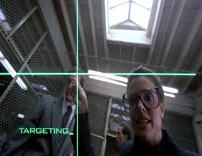
Fig. 7. RoboCop using his crosshair.
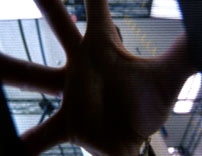
Fig. 8. Robocop’s “eye” is put into place.
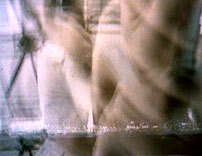
Fig. 9. RoboCop’s vision is adjusted.

Fig. 10. RoboCop’s interface-grid is installed.

Fig. 11. RoboCop watching his own embodiment.
(4) Extensive accounts for our bodily relation with technology can be found in N. Katherine Hayles’ How We Became Posthuman (1999) or Don Ihde’s Technology and the Lifeworld (1990). |
|
 |
 |
 |
 |
 |
|
 |
 |
 |
| |
Fakta
Bibliography
Branigan, Edward. Point of View in the Cinema: A Theory of Narration and Subjectivity in Classical Film. Berlin: Mouton, 1984.
Burch, Noël & Brewster, Ben. Life in those Shadows. Berkley: University of California Press, 1990.
Cerbone, David R. Understanding Phenomenology. Chesham: Acumen Publishing Limited, 2006.
Mascelli, Joseph V. The five C’s of Cinematography – Motion Picture Filming Techniques. Beverly Hills: Silman-James Press, 1965.
Sobchack, Vivian. The Address of the eye: A Phenomenology of Film Experience. New Jersey: Princeton University Press, 1992. |
|
|
|
|
 |
 |
 |
 |
16:9 - juni 2008 - 6. årgang - nummer 27
Udgives med støtte fra Det Danske Filminstitut samt Kulturministeriets bevilling til almenkulturelle tidsskrifter.
ISSN: 1603-5194. Copyright © 2002-08. Alle rettigheder reserveret. |
11 |
|
|
 |
 |
|
|